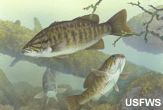Potomac 'Intersex' Fish Worry Scientists

WASHINGTON (AP) -- Scientists say abnormal "intersex'' fish, with both male and female characteristics, have been discovered in the Potomac River and its tributaries across the Capitol Region, raising questions about how contaminants are affecting millions of people who drink tap water there.
"I don't know, and I don't think anybody knows, the answer to that question right now: Is the effect in the fish transferable to humans?'' said Thomas Jacobus, general manager of the Washington Aqueduct, which filters river water for residents to drink in the District of Columbia, Arlington, Va., and Falls Church, Va.
So far, there is no evidence that tap water from the Potomac is unsafe to drink, according to Jacobus and officials at other area utilities.
Humans should be less susceptible to pollutants than fish because of their larger bodies and different hormone systems. And unlike fish, their bodies are not constantly exposed to the water.
The worrisome fish were first found in a West Virginia stream in 2003. Now, scientists are finding male smallmouth and largemouth bass with immature eggs in their sex organs at testing sites dotting the region.
Last month's testing at three tributaries emptying into the Potomac revealed that more than 80 percent of all male smallmouth bass found were growing eggs, according to Vicki S. Blazer, a fish pathologist with the U.S. Geological Survey.
At a testing site in Washington, seven of 13 male largemouth bass showed some kind of unusual feminine characteristic, Blazer told The Washington Post. Six of the seven tested positive for a protein used to produce eggs and three actually carried eggs.
Sign up for the Live Science daily newsletter now
Get the world’s most fascinating discoveries delivered straight to your inbox.
Although scientists have not identified the source or sources of the problem, the results appear to suggest that the Potomac River and its tributaries have a problem with so-called "endocrine disrupters,'' which can tamper with natural chemical signals.
In the past 10 years, pollutants mimicking hormones have raised alarms around the world as alligators, frogs, polar bears and other animals have developed abnormalities.
Scientists have identified a large number of pollutants that could be to blame -- including human estrogen from processed sewage, animal estrogen from farm manure, certain pesticides and soap additives.
The discovery in Minnesota over a decade ago of frogs with extra legs, ovaries in males and other deformities was considered an early warning sign of environmental distress linked to farm chemicals.
Congress in 1996 required the U.S. Environmental Protection Agency to study how the pollutants may affect human health. A decade later, however, officials said the agency hasn't tested any chemical, the Post reported.
"I would have hoped it would have been faster, but this is a very difficult program,'' said Clifford Gabriel, director of the EPA's Office of Science Coordination and Policy.
- Sewage and Intersex Fish
- Pollution Blamed for Intersex Fish
- Study: Polar Bear Genitals are Shrinking









